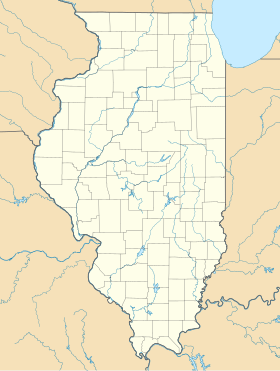
Totem poles are monumental carvings found in western Canada and the northwestern United States. They are a type of Northwest Coast art, consisting of poles, posts or pillars, carved with symbols or figures. They are usually made from large trees, mostly western red cedar, by First Nations and Indigenous peoples of the Pacific Northwest Coast including northern Northwest Coast Haida, Tlingit, and Tsimshian communities in Southeast Alaska and British Columbia, Kwakwaka'wakw and Nuu-chah-nulth communities in southern British Columbia, and the Coast Salish communities in Washington and British Columbia.

Lakeview, also spelled Lake View, is one of the 77 community areas of Chicago, Illinois. Lakeview is located in the city's North Side. It is bordered by West Diversey Parkway on the south, West Irving Park Road on the north, North Ravenswood Avenue on the west, and the shore of Lake Michigan on the east. The Uptown community area is to Lakeview's north, Lincoln Square to its northwest, North Center to its west, and Lincoln Park to its south. The 2020 population of Lakeview was 103,050 residents, making it the second-largest Chicago community area by population.
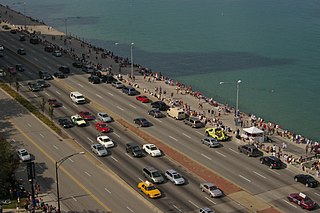
Lake Shore Drive is an expressway that runs alongside the shoreline of Lake Michigan, and adjacent to parkland and beaches, in Chicago. Except for the portion north of Foster Avenue, Lake Shore Drive is designated as part of U.S. Highway 41. A portion of the expressway on the Outer Drive Bridge and its bridge approaches is multilevel.

Jackson Park is a 551.5-acre (223.2 ha) urban park located on the South Side of Chicago. The park was designed in 1871 by Frederick Law Olmsted and Calvert Vaux, then greatly remodeled in 1893 to serve as the site of the World's Columbian Exposition, making it one of the largest and most historically significant parks in the city.
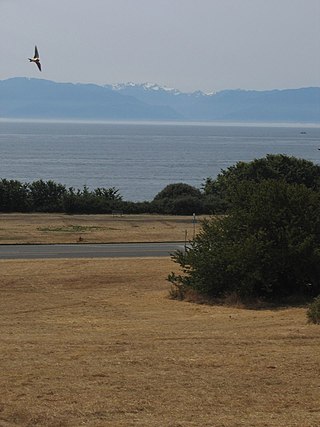
Beacon Hill Park is a 75 ha park located along the shore of Juan de Fuca Strait in Victoria, British Columbia. The park is popular both with tourists and locals, and contains a number of amenities including woodland and shoreline trails, two playgrounds, a waterpark, playing fields, a petting zoo, tennis and pickleball courts, many ponds, and landscaped gardens.

Brockton Point is a headland off the Downtown Peninsula of Vancouver, on the north side of Coal Harbour. Named after Francis Brockton, it is the most easterly part of Stanley Park and is home to a 100-year-old lighthouse and several hand-carved totem poles made in British Columbia. Like the rest of Stanley Park coastline, Brockton Point is lined by the Vancouver Seawall.

Thunderbird Park is a park in Victoria, British Columbia next to the Royal British Columbia Museum. The park is home to many totem poles and other First Nation monuments. The park takes its name from the mythological Thunderbird of Indigenous North American cultures which is depicted on many totem poles.

Tony Hunt Sr. was a Canadian First Nations artist noted for his KwaGulth style paintings and totem poles, which he carved from single cedar logs.

Virginia Water Lake lies on the southern edge of Windsor Great Park, in the borough of Runnymede in Surrey and the civil parishes of Old Windsor and Sunningdale in Berkshire, in England. It is a man-made lake taking its name from a natural body of water of the same name. There is a village of Virginia Water which stretches out to the east of the lake. The grounds of the lake, nearby Fort Belvedere, and the Clockcase are all Grade I listed on the Register of Historic Parks and Gardens.
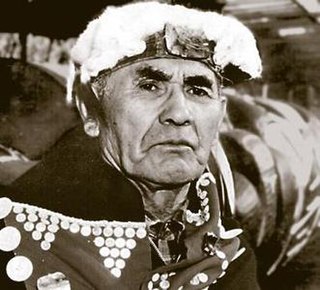
Chief Mungo Martin or Nakapenkem, Datsa, was an important figure in Northwest Coast style art, specifically that of the Kwakwaka'wakw Aboriginal people who live in the area of British Columbia and Vancouver Island. He was a major contributor to Kwakwaka'wakw art, especially in the realm of wood sculpture and painting. He was also known as a singer and songwriter.

George Hunt (Tlingit) was a Canadian and a consultant to the American anthropologist Franz Boas; through his contributions, he is considered a linguist and ethnologist in his own right. He was Tlingit-English by birth and learned both those languages. Growing up with his parents at Fort Rupert, British Columbia in Kwakwaka'wakw territory, he learned their language and culture as well. Through marriage and adoption he became an expert on the traditions of the Kwakwaka'wakw of coastal British Columbia.
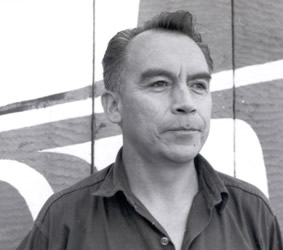
Henry Hunt was a First Nations woodcarver and artist from the Kwakwaka'wakw people of coastal British Columbia. He carved a number of totem poles which are on public display in Canada and internationally.

The Nisg̱aʼa Museum is a museum of the Nisg̱aʼa people that is located in Lax̱g̱altsʼap, a village in northwestern British Columbia, Canada. The Nisg̱aʼa name means "the heart of Nisg̱aʼa House crests," a name that celebrates the role of tribal crests in Nisg̱aʼa society. The museum is a project of the Nisg̱aʼa Lisims Government and opened in the spring of 2011. It is a place for display of Nisg̱aʼa artifacts, sharing traditions and ideas, and a centre for research and learning. The museum's collection of Nisg̱aʼa culture is "one of the preeminent collections of Northwest Coast aboriginal art" The museum's website states: "This is our gift to each other, our fellow Canadians and the world."

Big BeaverTotem Pole is a 55-foot (16.8-meter) tall outdoor totem pole sculpture by Norman Tait, of the Nisga'a people of British Columbia, located in front of the north entrance to the Field Museum of Natural History in Chicago, Illinois.
Simon Charlie or Hwunumetse' (1919–2005) was a Canadian totem sculptor of the Cowichan Tribes (Quw'utsun) of the Coast Salish nation, known for his wood carvings. He was born in Koksilah, on Vancouver Island, close to Duncan, British Columbia.

Stanley Clifford Hunt is a Canadian, First Nations Kwakiutl artist from British Columbia.
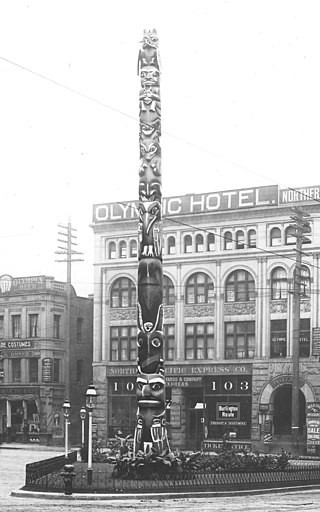
The Pioneer Square totem pole, also referred to as the Seattle totem pole and historically as the Chief-of-All-Women pole, is a Tlingit totem pole located in Pioneer Square in downtown Seattle, Washington.
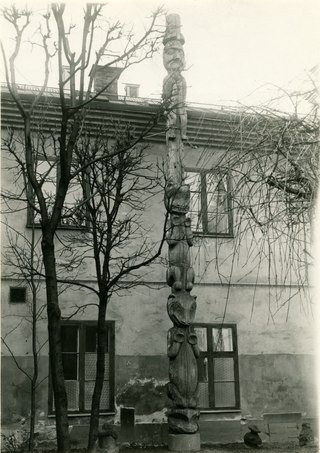
The Gʼpsgolox totem pole was a nine-metre-high mortuary pole that was made in 1872 by the Haisla people on the shore of Douglas Channel in British Columbia, Canada. In 1929 it was brought to Sweden and the Museum of Ethnography. In 2006 it was returned to the Haisla people. In 2012 it was allowed to decompose, in accordance with the Haisla tradition for long-serving poles.

Plaza Canadá is a public square in the Retiro neighbourhood of Buenos Aires, Argentina located within the streets of Maipú, Antártida Argentina, San Martin, and Dr. José María Ramos Mejía.
Tim Paul is a member of the Hesquiaht tribe from the Nuu-Chah-Nulth first nation. He is a master carver from Esperanza Inlet British Columbia. He was the senior carver at the Royal British Columbia Museum until 1992 when he left to oversee an indigenous education program for the Port Alberni school board on Vancouver Island.


